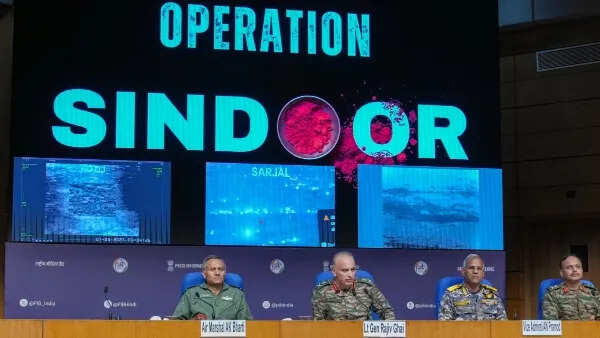New Delhi: After the terrorist attack in Pahalgam on 22 April, India once again made it clear to the world that it will now target not only the ground terrorists, but also their masterminds. This time India’s response was not only retaliation, but a clear message – now the “head will be cut”, not only the tail. As part of this strategy, India carried out ‘Operation Sindoor’ – a military campaign that shook the traditional war capabilities of Pakistan.
Not changed-mating edge
After the Pahalgam attack, on 9 May, India launched a pre-MP strike on the morning of May 10 in response to drone attacks on 26 locations in India by Pakistan. This was a 90 -minute accurate aerial action, targeting 11 important airbase of Pakistan. This action was not just retaliation, but an attempt to infatuate Pakistan’s war capacity strategically.
Large press conference of the three army chiefs on Operation Sindoor
Pakistan Air Force’s backbone broken
The bases that India targeted are considered to be the lives of Pakistan Air Force:
Noor Khan Airbase (Rawalpindi): The base near Pakistan’s military VIP Transport and General Headquarters was completely destroyed.
Sargodha (Musaf Base): Center for Pakistan’s nuclear delivery system and ‘Combat Commanders School’. Due to its destruction, PAF became blind and directionless.
Other hideouts: Rafiki, Marid, Sialkot, Skardu, Jackbabad, Sukkur, Pasur, Chuni and Bholari-F-16, JF-17, Mirage and Electronic Warfare Units were placed on these locations.
These attacks completely destroyed Pakistan’s Air Superiority. Their fighter aircraft, drone base, radar and war system became inactive in the same night.
Operation Sindoor
Indian Army Pulverizes Terrorist Launchpads
As a response to Pakistan’s misadventures of attempted Drone striks on the night of 08 and 09 May 2025 in Multiple Cities of Jammu & Kashmir and Punjab, the #Indian Army Conducted A Coordinated Fire Assault on… pic.twitter.com/2i5xa3k7uk
– ADG Pi – Indian Army (@Adgpi) May 10, 2025
Operation Sindoor: Decision
A few hours after the first phase, the Indian Army started the second phase of ‘Operation Sindoor’ at 1:04 pm. The attack was focused on 9 high-value targets of Pakistan and PoK:
Bahawalpur and Muridke: Headquarters of Jaish-e-Mohammed and Lashkar-e-Taiba.
Sialkot and Kotli: Important centers of infiltration and logistics.
Bhimber: Nerve center of ISI -run terrorist campaigns.
All these whereabouts were active in planning, training and arranging infiltration on India. In this 25 -minute strike, India shattered the entire network of terror.
Akashtir: India’s new military revolution
India’s game-changer proved to be “Akashtir” in this entire operation-a state-of-the-art indigenous real-time targeting and interception system. This system developed by DRDO, BEL and ISRO is included:
Navic-based procedures guidance
Satellite-linked autonomy
AI-operated stealth drone
This technology has provided India for the first time a completely indigenous, satellite-monitoring, AI-operated war system. This is the format of future war – where human intervention is minimal and decision is completely autonomous.
Psychological and strategic victory
India’s military reaction was not just a retaliation, but was about to shock the mental state of military and political leadership of Pakistan:
The security circle of Islamabad was shaken by the bombing of Noor Khan airbase.
The attack on Skardu stalled the Gilgit-Baltistan’s height monitoring system.
Chuni’s radars became blind, causing Pakistan to become blind in its own sky.
Pakistan’s nuclear threats exposed
The strategy of Pakistan’s long -standing “nuclear detection” collapsed in this operation. India showed that no threat can stop him now. Pakistan’s red lines became blurred as soon as the airbase burns one after the other. When the situation was out of control, Pakistan’s DGMO pleaded with India for a ceasefire. Army Chief General Asim Munir demanded mediation from the US, China and Saudi Arabia. But India refused to do backchainal diplomacy. The next phase – Attack on Pakistan’s energy and economic foundation – was also fully prepared.
Start of new regional military policy
‘Operation Sindoor’ was not just a military campaign, the foundation of a new Indian military policy:
Now every attack of terror will be replied in the full spectrum.
Atomic threats will be responded with military dominance.
The Indus Water Treaty is suspended, and this decision will not be withdrawn.
South Asia’s strength-balance changes
After this operation, Pakistan was diplomatically isolated, military weakened and strategically exposed. His confusion of strategic depth based on terrorism was broken. India made it clear that now it would make rules, decide speed and ensure punishment. ‘Operation Sindoor’ is still active. India has given a message to all concerned nations privately: “If Pakistan shoots, India will also run.” Now India does not just respond, it decides the rules.
